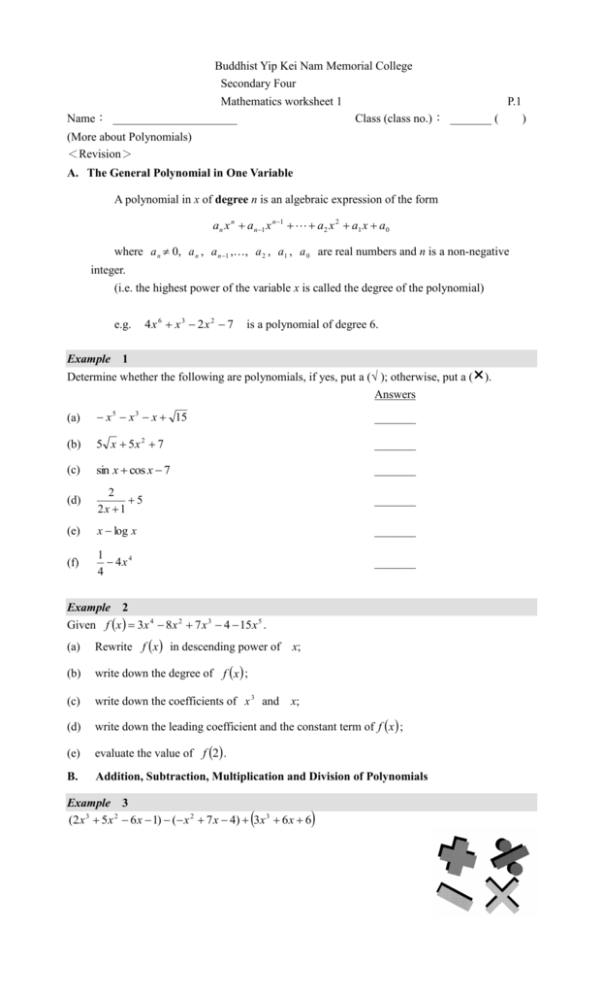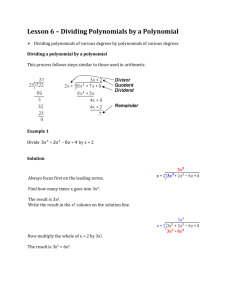B. Addition, Subtraction, Multiplication and Division of Polynomials
advertisement

Buddhist Yip Kei Nam Memorial College Secondary Four Mathematics worksheet 1 Name: _____________________ P.1 Class (class no.): _______ ( (More about Polynomials) <Revision> A. The General Polynomial in One Variable A polynomial in x of degree n is an algebraic expression of the form an x n an1 x n1 a2 x 2 a1 x a0 where a n 0, a n , a n1 ,…, a 2 , a1 , a 0 are real numbers and n is a non-negative integer. (i.e. the highest power of the variable x is called the degree of the polynomial) e.g. 4x 6 x 3 2x 2 7 is a polynomial of degree 6. Example 1 Determine whether the following are polynomials, if yes, put a ( ); otherwise, put a (). Answers (a) x 5 x 3 x 15 _______ (b) 5 x 5x 2 7 _______ (c) sin x cos x 7 _______ (d) 2 5 2x 1 _______ (e) x log x _______ (f) 1 4x 4 4 _______ Example 2 Given f x 3x 4 8 x 2 7 x 3 4 15 x 5 . (a) Rewrite f x in descending power of (b) write down the degree of f x ; (c) write down the coefficients of x 3 and (d) write down the leading coefficient and the constant term of f x ; (e) evaluate the value of f 2 . B. Addition, Subtraction, Multiplication and Division of Polynomials x; x; Example 3 (2 x 3 5x 2 6 x 1) ( x 2 7 x 4) 3x 3 6 x 6 ) Example 4 (2 x 3 x 2 5)( 4 x 1) x 3 2 x 2 8 x 1 P.2 Example 5 (a) (24 2 x 7 x 2 x 4 ) ( x 3) [By Long Division] (b) ( x 3 5x 2 3) ( x 2 x 3) [By Long Division] Division Algorithm Dividend = quotient divisor + remainder Example 6 When a polynomial is divided by x 3 , the quotient is 2 x 2 11x 27 and the remainder is 80. (a) Find the polynomial. (b) Find the quotient and remainder when the polynomial is divided by x 2 x 2 . C. Equality of Polynomials P.3 If two polynomials are equal for all values of x, then all the corresponding coefficients of the terms are equal. e.g. If ax 3 bx 2 cx d px 3 qx 2 rx s , then a = p, b = q, c = r, d=s Example 7 If ( x 1)( x 1)( x 2) Ax 3 Bx 2 Cx D , find the values of A, B, C and D. Example 8 If 15 x 12 A( x 1) 2 B( x 1)x 2 C x 2 , find the values of A, B and C. 2 Buddhist Yip Kei Nam Memorial College Secondary Four Mathematics worksheet 2 Name: _____________________ P.1 Class (class no.): _______ ( ) (More about Polynomials) <Theorems about Polynomials> A. Synthetic Division Example 1 By using the synthetic division, find the quotients and remainders of the following: (a) x 4 3x 2 5 x 4 x 2 ; (b) x 3 x 2 3x 1 x 3 ; (c) 2 x 4 3x 3 4 x 2 8x 2 x 3 . B. Remainder Theorem When a polynomial f(x) is divided by (x a), the remainder is equal to f(a). b Note: If a polynomial f(x) is divided by (ax b), the remainder is f ( ) . a Example 2 Find the remainders when x 3 4 x 2 5x 7 is divided by (a) x 1, (b) 2x 1 . Example 3 When the polynomial x 2 12 x 3 value of k. is divided by ( x k ), the remainder is k 2 1 . Find the Example 4 P.2 3 2 When the polynomial 2 x ( k 1) x 3kx 5 is divided by ( x 2 ), the remainder is 1. Find the values of k. Example 5 When the polynomial f x x 3 ax 2 4 x b is divided by x 3 , the remainder is 40; and f x is divisible by x 5 . Find the values of a and b. Example 6 Given that f x ax 2 3x 2 they are divided by x 1 . (a) (b) and g x x 2 x 1 have the same remainders when Find the value of a. Find the value of x when f x g x . Example 7 Given that f x 2 x 3 7 x 2 ax 5 Find the values of a and b. is divisible by 2 x 1 and the quotient is x 2 bx 5 . C. Factor Theorem P.3 If f(x) is a polynomial and f(a) = 0, then (x a) is a factor of the polynomial f(x). Note : If (x – a) is a factor of the polynomial Example 8 If (x 1) is a factor of Example 9 Prove that x 5 f(x), then f(a) = 0. f ( x) x 4 ax 3 4 x 7 , find the value of a. is a factor of f ( x ) = x 3 8 x 2 17 x 10 . Hence, factorize f ( x ) completely. Example 10 Let g x 1 x 3 3x 2 10 x 24 . (a) Find g x . (b) Show that (x + 1) is a factor of g x . (c) Hence, factorize g x completely. D. Applications of the Factor Theorem P.4 Method of Factorization (i) Factorization by taking out the common factors: (ii) Factorization by the cross method: ab ac a (b c) 6 x 2 x 1 (2 x 1)(3x 1) (iii) Factorization by using some identities: (1) (2) (3) (4) Perfect squares: Difference of two squares: Sum of two cubes: Difference of two cubes: Example 11 Given x 3 2 x 2 mx 6 (a) (b) Find the value of Hence, factorize x 2 x 2 mx 6 Example 12 Factorize x 3 x 2 49 x 49 . Hence, solve x 3 x 2 49 x 49 0 . (a b) 2 a 2 2ab b 2 a 3 b 3 (a b)(a 2 ab b 2 ) a 3 b 3 (a b)(a 2 ab b 2 ) m. 3 (a b) 2 a 2 2ab b 2 a 2 b 2 (a b)( a b) is divisible by x 1 . Solving Cubic Equations (a) (b) (a) (b) completely.








